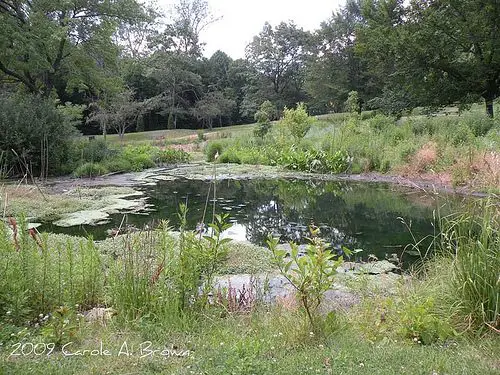What is a Rain Garden?
The concept of rain gardens was developed in the late 1980s in Prince Georges County, MD and termed “bioretention”. The idea was to use planted areas as a sponge to soak up polluted stormwater and filter out impurities before allowing the water to slowly be absorbed into groundwater aquifers.
Stormwater management has become quite costly for municipalities. The use of bioretention facilities is much more cost effective than traditional stormwater methods, and this approach treats water as a resource, not as waste.
Bioretention facilities can be designed either as ponds, ditches, or as the much shallower applications, which, at the level of use by homeowners, are called rain gardens.
When a rain event occurs that is beyond the capacity of your rain barrels, this overflow can then be directed to your rain garden, also called infiltration gardens.
While an individual rain garden may seem like a pretty small thing, collectively they can
divert substantial amounts of water from the municipal stormwater system.
That is the point of Ecosystem Gardening: the cumulative effects of all of us working to conserve natural resources and create habitats for wildlife can amount to significant progress in reversing the trends of species decline due to habitat loss.
It is important to note that if you have installed a green roof, there will be very little runoff except in larger rain events. I know some people who have installed green roofs on one side of their homes and rain barrels and rain gardens on the other sides. In this way, they are reusing the runoff from each downspout in a different way.
So what exactly is a rain garden? It is a shallow area dug into your garden into which your rainwater or water from your sump pump is diverted. Usually they do not need to be more than 4-8″ deep. Water is held here until it is slowly absorbed into the soil and can enter groundwater aquifers.
Rain gardens are different than ponds in that they do not require a liner, and are dry between rainfalls. This area is then planted with native wetland or wet prairie wildflowers and grasses.
These gardens provide food and shelter for birds, butterflies and beneficial insects, such as mosquito-devouring dragonflies.
This type of garden contributes to ecosystem function by acting as a filter to protect streams and watersheds from pollutants carried in run-off such as fertilizers and pesticides, oil and other leakages from cars, and other substances that are washed off roofs and other paved areas.
Installing a Rain Garden
Installation of a rain garden is relatively easy.
Invite some neighbors over to help, with the reward of a great meal after digging is finished. Recruiting your neighbors is a great method to install your rain garden because you can educate them about the benefits of this type of garden, and encourage them to install one as well, even promise to help them install theirs after yours is completed. Steps of installation include:
- Choose an area down-slope and at least 30′ from your house to protect your foundation from water seepage
- An area in full sun is best, but a mostly sunny spot will work, too.
- Use your garden hose to mark the layout of your new garden. Be creative with shape; let your imagination soar. This is your garden and can have any form you choose; they can be curvilinear or rectangular, but try to think outside the “kidney”
- The rain garden should have gently sloping sides and a level bottom.
- And now the fun part, planting! Choose native wetland or wet prairie plants that are adapted to your region and soil type
Determine Rain Garden Size
Your rain garden can be as large as you wish, but if you are not using any other rain capturing methods, you will need to determine how big it needs to be to handle all of the runoff from your roof.
- First, look at your soil. Sandy soil drains much quicker than silty loam, which drains much quicker than clay.
- Measure the total area of runoff that will be directed to your rain garden. If you are not using the downspouts from the whole roof, measure only the area that will feed to the rain garden (area is determined by multiplying length x width). The area of my roof is 18′ x 54 = 972 square feet, if using the whole roof
- A formula has been developed for determining minimum rain garden size (University of Wisconsin, 2003). We will use a depth of 6″ for all applications
- For sandy soil, multiply the run-off area by 0.15 (Mine would be 972 x 0.15 = 146 square feet)
- For Silty Loam, multiply by 0.25 (Mine would be 972 x 0.25 = 243 square feet)
- For clay soil, multiply by 0.32 (Mine would be 972 x 0.32 = 311 square feet)
- You can develop several smaller rain gardens, each to be fed by a different downspout
- Plant choice will be determined by your local conditions. A good source of information is the native plant society in your state. A mix of grasses, sedges, and wildflowers with differing bloom times will give you a beautiful garden through all seasons.
More From Ecosystem Gardening:
Submit your review | |








